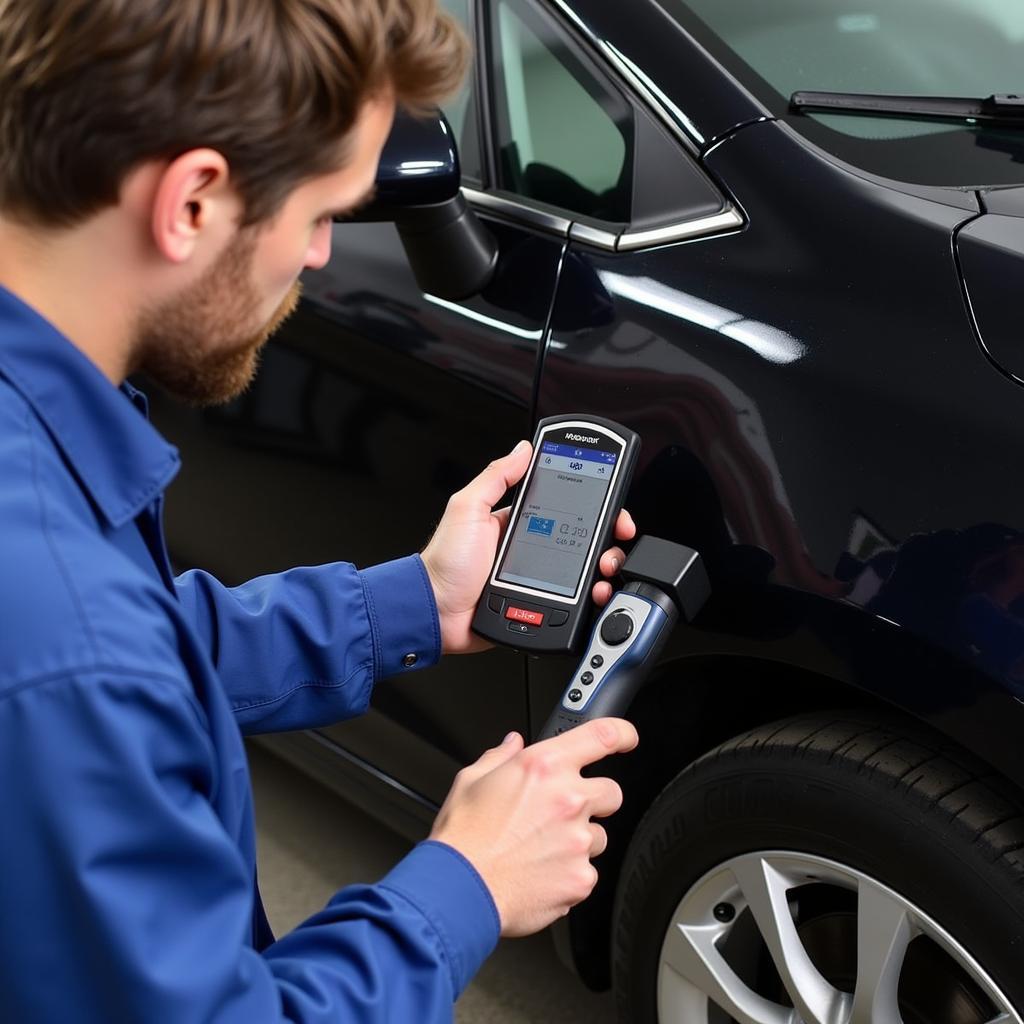Tire pressure monitoring systems (TPMS) are crucial for vehicle safety and efficiency. A Car Scanner Tpms tool can diagnose and fix TPMS issues, saving you time and money. This article explores everything you need to know about using a car scanner for TPMS, from understanding the technology to troubleshooting common problems.
After a tire rotation or change, your TPMS sensors may need to be reset. A car code scanner with reset can efficiently handle this task, among others.
Understanding TPMS and its Importance
TPMS technology alerts drivers to low tire pressure, a common cause of accidents and reduced fuel economy. By providing real-time pressure readings, TPMS helps prevent blowouts, improves handling, and extends tire life. Ignoring TPMS warnings can lead to dangerous situations and costly repairs.
Types of TPMS: Direct vs. Indirect
There are two main types of TPMS: direct and indirect. Direct TPMS uses sensors within each tire to measure pressure and transmit data wirelessly to the vehicle’s computer. Indirect TPMS relies on the wheel speed sensors of the anti-lock braking system (ABS) to estimate tire pressure based on rotational speed differences. Direct TPMS is generally more accurate and provides specific pressure readings for each tire.
Using a Car Scanner for TPMS Diagnostics
A car scanner TPMS tool can access the data from the TPMS sensors and provide valuable information for diagnostics. It can display individual tire pressures, sensor IDs, battery life, and error codes. This information helps pinpoint the exact location and nature of a TPMS problem.
How to Read TPMS Data with a Car Scanner
Connect the scan-tool to the vehicle’s OBD-II port. Select the TPMS option on the scanner’s menu. The scanner will then communicate with the TPMS module and display the relevant data. Some scanners may require specific software or adapters for TPMS functionality. Ensure your scanner is compatible with your vehicle’s make and model.
Troubleshooting Common TPMS Issues
TPMS problems can range from simple sensor malfunctions to complex wiring issues. Here’s a breakdown of common issues and how a car scanner can help:
- Low Tire Pressure: The most common trigger for a TPMS warning is simply low tire pressure. Inflate the tires to the recommended pressure and use the car scanner to confirm the readings.
- Faulty Sensor: A car scanner can identify a malfunctioning TPMS sensor by its unique ID. This allows for targeted replacement without unnecessary guesswork.
- Dead Sensor Battery: TPMS sensors have batteries that eventually die. A car scanner can often detect a weak or dead battery, indicating the need for sensor replacement.
- TPMS Reset Issues: After tire rotation or sensor replacement, the TPMS system needs to be reset. Some scan tool that can reset toyota tpms can perform this reset function, simplifying the process.
What if my scan tool doesn’t show TPMS data?
Not all scan tools offer TPMS functionality. If yours doesn’t, consider investing in a dedicated TPMS tool or an obd scan tool that will do tpms toyota for specific vehicle makes.
Choosing the Right Car Scanner TPMS Tool
When selecting a car scanner with TPMS capabilities, consider factors like vehicle compatibility, functionality, user interface, and price. Some scanners offer advanced features like sensor programming and relearn procedures.
“Investing in a quality car scanner TPMS tool can significantly reduce diagnostic time and improve the accuracy of repairs,” says automotive expert, Michael Anderson. “It’s an essential tool for any professional mechanic or serious DIY enthusiast.”
Benefits of Using a Car Scanner for TPMS
Using a car scanner for TPMS offers several advantages:
- Accurate Diagnostics: Pinpoint the exact cause of TPMS issues, eliminating guesswork and unnecessary part replacements.
- Time Savings: Quickly diagnose and resolve TPMS problems, saving valuable time in the shop or garage.
- Cost Savings: Avoid costly repairs by identifying and addressing issues early on.
- Improved Safety: Ensure proper tire pressure for optimal vehicle safety and performance.
Conclusion
A car scanner TPMS tool is an invaluable asset for anyone working with vehicle maintenance. It allows for accurate diagnostics, quick troubleshooting, and improved safety. By understanding how to use a car scanner for TPMS, you can save time, money, and ensure a safer driving experience. For professional tools and more information, contact ScanToolUS at +1 (641) 206-8880 or visit our office at 1615 S Laramie Ave, Cicero, IL 60804, USA.
“Regularly checking your TPMS with a car scanner is a proactive step towards preventing tire-related problems,” adds Susan Miller, a certified automotive technician. “It’s a small investment that can pay off big in the long run.”
If you’re looking for a reliable car scanner in Canada, consider the launch car scanner canada for a powerful and versatile option.
FAQ
- Do all cars have TPMS? Most vehicles manufactured after 2007 are equipped with TPMS.
- How often should I check my TPMS? It’s recommended to check your tire pressure monthly and anytime the TPMS warning light illuminates.
- Can I reset my TPMS myself? Yes, many car scanners allow for TPMS resets.
- What does a flashing TPMS light indicate? A flashing TPMS light typically indicates a problem with the TPMS system itself.
- How long do TPMS sensors last? TPMS sensor batteries typically last 5-10 years.
- What is the cost of replacing a TPMS sensor? The cost varies depending on the vehicle make and model but typically ranges from $50 to $200 per sensor.
- Can I drive with a faulty TPMS sensor? While you can technically drive with a faulty sensor, it’s not recommended as you lose the important safety feature of tire pressure monitoring.

